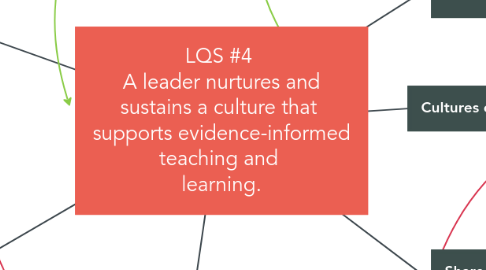
1. Meaningful, collaborative learning opportunities
1.1. Collaboration needs to be expected, inclusive, ongoing, and genuine to improve students outcomes (Stoll, et.al, 2006)
1.1.1. Practical Connections
1.1.1.1. coherent classroom practices and assessment
1.1.1.2. colllaborative prep. time
1.1.1.3. Grade team professional development
1.1.1.4. problem driven Lunch and Learns
1.1.1.5. shared professional learning
1.2. Building shared capacity through shared goals, culture, and structure (Leithwood & Mascall, 2008)
2. Positive involvement of parents
2.1. The Interconnectivity of Trust in Schools - Megan Tschannen-Moran
2.2. Promoting a Culture of Parent Collaboration and Trust: An Empirical Study (Adams & Forsyth, 2013)
2.2.1. practical connections
2.2.1.1. parent contribution of student strengths and needs
2.2.1.2. parent volunteers
2.2.1.3. ongoing parent communication
2.3. Leadership in high achieving school is successful at protecting teachers from undue pressure from parents ( Robinson, 2007)
3. community service agencies and wrap around support
3.1. A group of people inside and outside the school can enhance pupils' learning and school development (Stoll, et.al, 2006)
3.1.1. practical connections
3.1.1.1. building relationships with wrap around organizations
3.1.1.2. understanding funding models for wrap around support
3.2. increase the scope of those providing influence (Leithwood & Mascall, 2008)
4. Through line 1: Student Centered Learning
5. creating an inclusive learning environment
5.1. promoting differentiated learning opportunities for students as well as teachers. (Grierson & Woloshyn, 2013)
5.2. Learning experiences that capitalize on students cultural, experiential, and personal backgrounds in order to build new understandings (Tomlinson, Ann & Imbeau, 2013).
5.2.1. Practical Connections
5.2.1.1. differentiated outcomes, products, resources
6. Shared responsibility for student success
6.1. Significant achievement gains in schools that take collective responsibility for student learning (Nehring & Fitzsimons, 2011).
6.2. Coherent classroom approaches and common priorites ( Jacobson, 2010).
6.2.1. Practical Connections
6.2.1.1. Shared Google docs to track student behavior.
6.2.1.2. https://docs.google.com/spreadsheets/d/15v9734Vbdp2dYWVE3e3324kVdHsFUKkge4khsZVc-9g/edit#gid=0
6.2.1.3. Shared communication with wrap around support.
